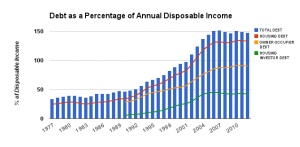Debt. Debt is constantly looming at us. It is now a key element of the political-ideological constellation of our time. Debt expresses both the current crisis of capitalism in its economic guise and also the ‘representation of the imaginary relationship of individuals to their real conditions of existence’(Althusser, 2008, p. 36). Debt is pervasive, all encompassing and seemingly inescapable. The debt of Australian households is steady at 150% of income(Reserve Bank of Australia, 2013). If Australians only spent at the levels of their income it is more than probably that great sections of capital – especially retail – would no longer be viable. The majority of debt is tied up in mortgages: the major asset of most households is not only purchased by going into serious debt but only can maintain its value because the society as a whole is steeped in debt.
 Graph: (Bird, 2013)
Graph: (Bird, 2013)
It was the US Sub-Prime Mortgage crisis that triggered this current, seemingly permanent, economic malaise – and it is now sovereign debt, that is the debt of states, that is the part of its current manifestation. (Neither are the source of the crisis itself – for that you need to look deeper into the structure and history of capitalism.) The sharpest expression of this is the looming possibility that the US will not raise its debt ceiling and thus be compelled to either drastically cut state expenditure or default on its debt. Since US debt, in the form of Treasury Bills, make up a core component of the global economy, such a default would, in the words of IMF Christine Lagarde ‘…cause serious damage to the US economy, but also to the global economy as a result of the spillover effects.’
Continue reading “Debt and the Limited Imagination of the Left”